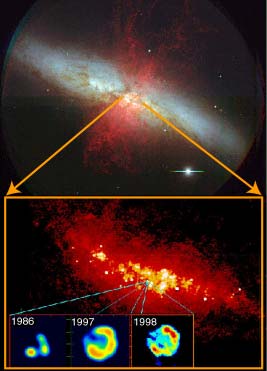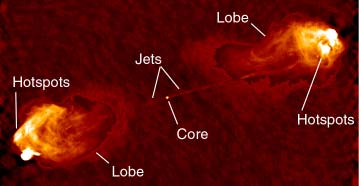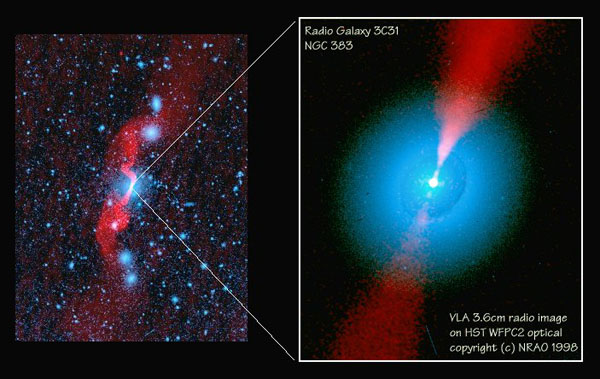
Figure 13. At top is an optical image, taken with the Subaru telescope, of the nearby starburst galaxy M82. Below is a MERLIN/VLA radio image of the very central regions of M82.
We have already seen that the stars which dominate our view of the sky at visible wavelengths are almost invisible in the radio. Instead the radio sky is dominated by diffuse emission from material in our galaxy. This diffuse emission is scattered with small point-like sources of radio emission, appearing much like stars do in the visible sky, see Figure 6. Some of these are associated with nebulae in our galaxy but the vast majority are much more distant, outside the galaxy altogether.
These extragalactic ("outside our galaxy") radio sources are associated with distant galaxies. There are many such types of extragalactic radio source but they can be classified into two broad groups: the "starbursts" and the radio sources associated with AGN's (active galactic nuclei). It has recently become apparent that the starburst galaxies are in fact the most numerous type of extragalactic radio source although they are much less conspicuous than those associated with AGN which make up more than 99% of the brightest hundred thousand radio sources in the sky. This is because the latter are far more luminous than the starbursts and so can be seen into the furthest reaches of the universe.
Starburst galaxies are bright in the radio because they are undergoing a massive amount of star formation (hence the name) leading to the type of radio emission we see in our own galaxy (e.g. in Figure 6) although on a much larger scale. Figure 13 shows MERLIN/VLA observations of the nearby starburst galaxy M82. The optical image shows hydrogen gas (red) being flung out in directions above and below the main disc of the galaxy. The radio waves see through to the dust enshrouded core and reveal a population of very young supernova remnants (the bright points in this image); the inset shows how one of them has expanded over a decade or so. It is this high rate of supernova explosions which drives the galactic wind seen in the optical image.
 |
Figure 13. At top is an optical image, taken with the Subaru telescope, of the nearby starburst galaxy M82. Below is a MERLIN/VLA radio image of the very central regions of M82. |
The radio sources associated with AGN are a completely different type of object, far out of the realm of what we can see in our own galaxy and hence more difficult to understand. AGN are found in the centres of large host galaxies. Within the central light-year of an AGN is contained millions to billions of solar masses of material - we infer this from its gravitational effect on matter swirling around it, just as we do for the centre of our own galaxy. Measurements of timescales of variations in the light emitted by the bright sources of radiation at the centres of AGN suggest they may be very small indeed, smaller than our solar system. Many astronomers believe that this is evidence for the presence of supermassive black holes. The energy driving these ultra-luminous objects is derived from the gravitational potential energy of material falling into the central black holes. The brightest radio galaxy is Cygnus A (the A meaning brightest radio source in the constellation of Cygnus) - see Figure 14. Cyg A is so bright it can also be easily seen on the all-sky map of Figure 1.
 |
Figure 14. VLA 6cm radio image of the Cygnus A radio galaxy (Carilli) labelled with the main features of such sources. |
Possibly the weirdest feature of AGN is that often two narrow jets of material are spewed out in opposite directions, Figures 14 and 15. These extend well outside the galaxy and end in giant lobes of radio-emitting plasma. It seems likely that the jets are composed of high-velocity material being ejected perpendicular to the plane of a disc of material swirling into the black hole. The jets are then decelerated at hotspots where they ram into the surrounding tenuous gas - the jet material is then mixed with ambient material and inflates the wispy lobes seen in the radio images. The exact mechanism by which these jets are generated is not yet clear. Some of the jets show superluminal motion like that discussed in the microquasars in the previous module - in fact the name microquasars arises from their appearing like a scaled down version of quasars, a particular class of extragalactic radio sources. The name quasar stems from the acronym QSO, itself standing for Quasi-Stellar Object since early optical observations of these extremely strong radio sources showed them to be point-like, just like stars. More recently deep observations have shown that quasars lie at the centre of galaxies which can be faintly seen on the deepest images but which are almost obscured by the blinding light from the quasar itself.
 |
Figure 15. The radio galaxy 3C31. Red: VLA radio images; Blue: optical images Left: VLA 21cm radio image (red) superposed on optical image (blue) from the Digitized Palomar Sky Survey. Right: Close-up of the central region with VLA 3.6cm radio image (red) superposed on Hubble Space Telescope optical image (blue). [Radio data of Robert Laing (RGO), Alan Bridle and Richard Perley (NRAO), Luigina Feretti, Gabriele Giovannini and Paola Parma (Bologna); HST image from Martel et al.(1999)]. |
There are many different types of AGN classified on their observational characteristics. In recent years it has become popular to invoke a "unified model" for AGN which suggests that these differences only occur because we are viewing the same types of object at different angles. Seen side-on the central engine (the region around the putative supermassive black hole) is obscured from our view by a dense dusty torus (doughnut) of material. We then only see the large-scale phenomena such as the jets and radio lobes.